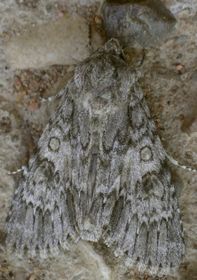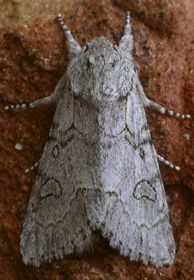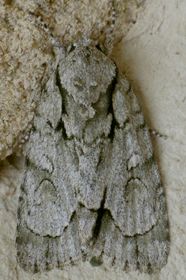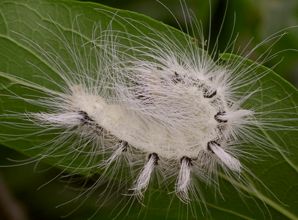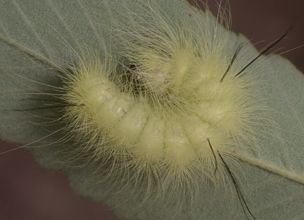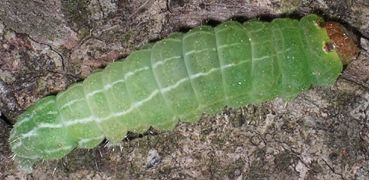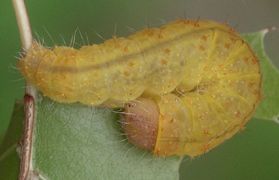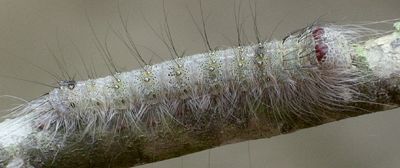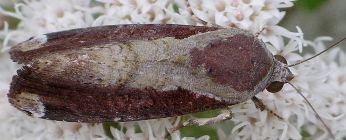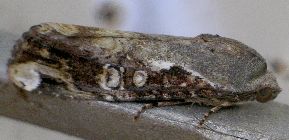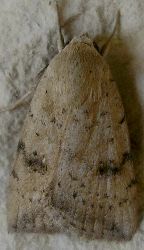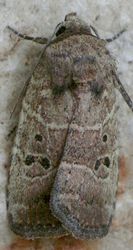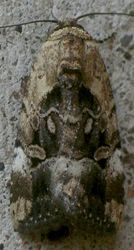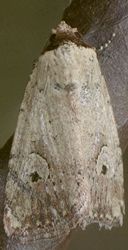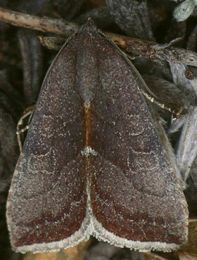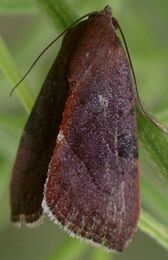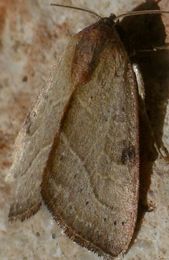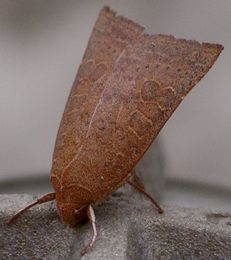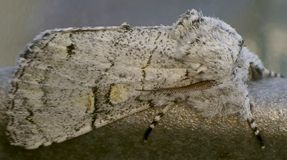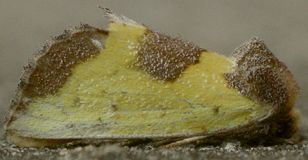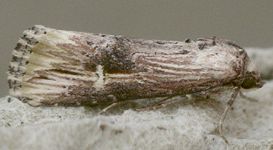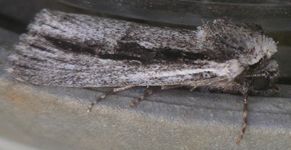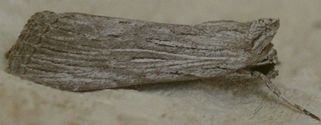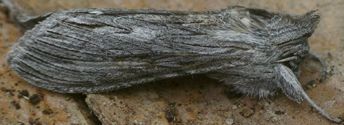
| Noctuidae ~ Owlet Moths |
page 1 ![]() page 2
page 2 ![]() page 3
page 3 ![]() page 4
page 4 ![]() page 5
page 5 ![]() page 6
page 6 ![]() page 7
page 7 ![]() page 8
page 8
|
One rather large genus of noctuids is Acronicta, the daggers. They are so named because many of the adults have black streaks on their wings that appear dagger-like. In more practical terms, these adult moths are very heavily marked, mostly gray, and as difficult to tell apart as the underwings are. You have to pay attention to minute details and still allow for slight variations.
Three species that I've seen so far are pictured below, all generally attracted to lights. The Delightful Dagger (Acronicta vinnula) is the most common one I see. It is about 20 mm long and shows up mostly in the spring, but I've also seen it in the fall. Acronicta tota is sometimes rather common; it's about 18 mm long and I've seen it only in March. I find its very delicate fine line markings quite attractive. Although the Ruddy Dagger is common as a caterpillar, I've only seen an adult once, in April. It is about the same size as the previous two, at 19 mm in length.
Although the adults are invariably gray and similar, the Acronicta caterpillars couldn't be more diverse. The Ruddy Dagger feeds on Hackberry and can be very numerous at times. The American Dagger (A. americana) prefers Red Buckeye (Aesculus pavia) and is not nearly so numerous. Note the characteristic curved posture that these caterpillars assume when disturbed, or sometimes even when just resting. They are usually found on the undersides of leaves.
I've seen only one Delightful Dagger caterpillar and it was wandering, probably ready to pupate. As you can see, it is translucent green. It has two little brown "ears" right behind its head.
The unidentified Dagger caterpillar shown above was eating Red Oak. There's that curved posture again.
The Greater Oak Dagger (A. lobeliae) is one cool caterpillar. At first glance, it looks like a lasiocampid, but there are enough differences that it is an easy ID once you get to the correct family. The maroon spots on the back of the head are particularly distinctive. I found this one in our own yard.
The Orbed Narrow-wing (Magusa orbifera) is an occasional sighting in Oct., as it feeds at flowers. It's about 20 mm long and has variable markings, but the white spots on the wing tips seem to be good field marks. There are several very cute little moths called midgets (Elaphria spp.). We have three species in our area and they are not all that common except that one year I saw several E. alapallida in April. All are about 11 to 12 mm long and are very compact. The Chalcedony Midget (Elaphria chalcedonia) is the only one with a common name. I have found it throughout the year, but only one at a time. I've seen Elaphria fuscimacula only once, in July, and it was in Kerrville, not Austin. E. alapallida (whose name undoubtedly refers to the light-colored wings) is a rather recently recognized species separate from the Festive Midget (E. festivoides), which it resembles. Note that it has a dark brown "collar."
Another similar attractive little species is Micrathetis triplex. This one is sleeker looking than the midgets but is the same size. I have only seen it once, in May.
A favorite moth of mine is The Wedgling (Galgula partita). What is there not to like about an insect that is, in spite of highly variable colors,
Another smaller noctuid is the Red-winged Sallow (Xystopeplus rufago). This is one well-groomed moth, not a hair out of place. The Red-winged Sallow is about 15 mm long and has the distinctive habit of resting on its head, with its wings pointing up in at least a 45° angle. That posture, combined with its color and the fact that it shows up in February, makes identification a cinch. I've addressed a few moths previously that look like they could be in families other than Noctuidae, and here are a couple more. Charadra dispulsa is a lovely medium-sized (17 mm long) moth that looks hairy enough to be a notodontid, or prominent. Well, it's not. It is attracted to lights in the spring and its silvery color often stands out against sidewalks and sides of buildings.
Stiria intermixta is a similar "high profile" species. I've only seen it once, in October, attracted to lights. It is about the same size as Charadra dispulsa but the yellow and brown markings are so distinctive that identification is not a problem. A species whose adults I've never found is Neogalea sunia. The caterpillars, though, are easy to find on their host plant, Lantana. I probably should not say "easy" because they are very well camouflaged and I would never have noticed them if it were not for Dr. David Wagner of U. of Connecticut requesting that I collect some for him. These larvae look sort of like those of zales, and have the same sort of rear end point; they stretch out along the woody stems and are nearly invisible. They appear just as the Lantana is leafing out in the late spring. Young caterpillars have fine stripes that match the plant stems perfectly. The stripes fade in older individuals.
There are several long and slender noctuid adults that also seem to mimic pieces of stem or wood. These must be viewed from the side to be recognizable; they don't look like much of anything from above. The Verbena Moth (Crambodes talidiformis) is an uncommon springtime moth. It is only about 13 mm long and doesn't really look very much like most noctuids, being so slender. Sympistis atricollaris is another rather long (20 mm long, in fact) and slender moth. I've only seen it once, attracted to lights in the spring. The black streak and lack of any other obvious markings are good ID clues.
The hair on the thorax of a moth can come in many shapes, from a scruffy mess to a neat coiffure. The Fine-lined Sallow (Catabena lineolata) has a point over its head, formed completely by its hairy back! This 13 mm long moth is seen in April and is not very common.
Members of the genus Cucullia also have a point of hair over their heads. They are similar to, but larger than, the Fine-lined Sallow. Adult cucullias are about 24 mm long, slender and gray with fine dark lines. The species are very hard to tell apart. Their caterpillars are quite common every year in the fall, feeding on mostly on Broomweed, but sometimes on other composites such as Bitterweed and Tansy Aster. They are very colorful and rather large (up to about 40 mm long), with a shiny texture. I raised a couple of these larvae and the adults seem to be Cucullia laetifica. I'm not positive. Although I find a lot of caterpillars, I've never found an adult in the wild, so I have very little experience with this genus. The larvae are so variable that I wouldn't be surprised if we have more than one species in the area.
Another colorful caterpillar whose adult I've never encountered is the Toadflax Brocade (Calophasia lunula). The 30 mm long larvae are not shiny like cucullias but have similar complex color patterns of black or gray, white and yellow. They are slender and feed on Texas Toadflax (Linaria texana) in our area, often resting along the vertical stems. In spite of their patterns, they are not easy to see! Like the plant, they are found only in the spring.
|
page 1 ![]() page 2
page 2 ![]() page 3
page 3 ![]() page 4
page 4 ![]() page 5
page 5 ![]() page 6
page 6 ![]() page 7
page 7 ![]() page 8
page 8
![]()
